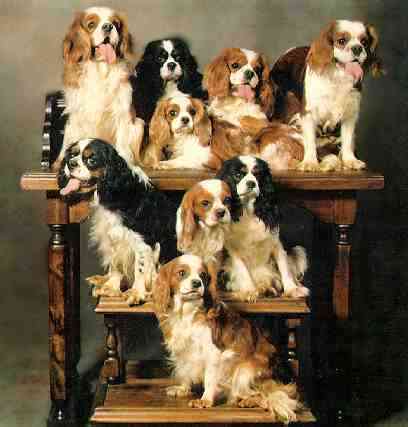Health Concerns - Royal Oak Cavaliers
Main menu:
- Home
- About Us
- Breed Information
- Health Concerns
- Diet
- News
- Boys
- Girls
- Puppies
- Links
- Email Us
-
Pictures
- Ireland
- Alberta
HEREDITARY HEALTH ISSUES - NO REAL 100% GUARANTEE
It is important to understand that even if the sire and dam have been screened and found clear of any health problems, no breeder can guarantee that a puppy will never develop a problem during its life time. But, screening does lessen the chance.
MITRAL VALVE DISEASE We test the dogs we breed for heart murmurs (by a Board Certified Cardiologist) as these are a precursor of Mitral Valve Disease, we OFA x-ray hips, CERF check eyes (by a Board Certified Ophthalmologist) and DNA tests for Episodic Falling Syndrome (EFS) and Dry Eye/Curly Coat. We do the best we can with the information available at that time. There are no guarantees in breeding any living being. If you buy a puppy from me that develops a life threatening hereditary disease under one year of age, it will be replaced. We will not pay for surgeries to correct any problem.
UNDESCENDED TESTICLES can be a common problem with this breed. The breed was developed in England from the English Toy Spaniel. From 1910-1940 it was common practice to breed dogs with undescended testicles. Although not recommend by the Kennel Club of England at the time, Cavalier breeders only had a few bloodlines to work with so inbreeding was the only way for them to achieve their goal. So, this is why we will see a Cavalier puppy with undescended testicles, or with only one descended testicle. This is not a health concern for the owner of a pet Cavalier, but would be for a stud dog owner. Cavaliers with undescended testicles may take up to 8 months to fully descend into the scrotum so give it a little time.
UMBILICAL HERNIA also seems to be a common problem with this breed due to the small gene pool. An umbilical hernia is an opening in the wall of the abdomen where the umbilical cord was. Occasionally a little fat may push through but quite often it will heal over and close as the puppy grows older. Umbilical hernias do not cause any health issues, and they are very easy to fix during spay/neuter time.

Home | About Us | Breed Information | Health Concerns | Diet | News | Boys | Girls | Puppies | Links | Email Us | Pictures | General Site Map